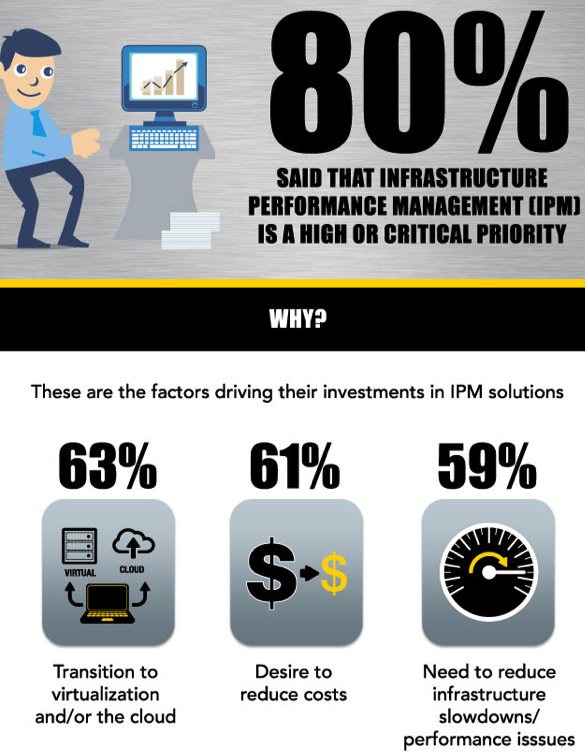Infrastructure Performance Management High Or Critical Priority
Survey from IDG Research Services announced by Virtual Instruments
This is a Press Release edited by StorageNewsletter.com on November 18, 2013 at 2:30 pmVirtual Instruments, Inc. announced the results of a survey from IDG Research Services.
The survey was designed to understand the priority enterprise organizations place on IPM and how the structure of many IT departments is changing to more effectively manage the performance of their IT infrastructure.
The findings show that 80% of senior-level IT leaders (director-level or higher) place a high or critical priority on IPM and that 79% have established a cross-domain team dedicated to managing the performance of their IT infrastructure.
The survey was completed by 152 IT director-level or higher employees across various industries, including financial services, manufacturing, and healthcare, at organizations with employees in the 5,000-50,000 range. Questions focused on the factors driving adoption of IPM solutions, which is defined as those that enable an enterprise to holistically monitor, report, trend and diagnose IT infrastructure performance.
According to the survey, senior-level IT leaders indicated that investments in IPM solutions are being driven by the transition to virtualization and/or the cloud (63%), a desire to reduce costs (61%) and the need to reduce infrastructure slowdowns (59%). In addition, 53% of respondents said that a growing mobile workforce and data center consolidation projects are driving their investments in IPM solutions.
According to respondents, there are real business advantages to investing in IPM solutions, including increased visibility into infrastructure performance, improved customer service, improved business agility and more informed decision making.
The survey revealed that investments in IPM solutions have paid off:
- 66% of respondents have seen or expect to see improved system efficiencies.
- 61% of organizations saw or expect to see reduced downtime or slow time.
- 66% of respondents plan to increase the level of investment in IPM solutions in 2014.
“Now more than ever, large enterprise organizations benefit from having the right technology solution, as well as a cross-domain team in place to ensure the availability and performance of mission-critical applications that rely on the IT infrastructure,” said John Gentry, VP marketing, Virtual Instruments. “A comprehensive IPM platform gives IT the insight it needs to build stronger relationships with business leaders, mitigate risks and positively impact the organization’s bottom line.”
The Value of Cross-Domain IPM Teams
As the importance of having an end-to-end view of the IT infrastructure grows, nearly four out of five responding organizations (79% of respondents) have established IPM teams dedicated to managing the performance of their IT infrastructure. 30% of organizations have teams that include individuals from across IT and line of business (LOB) functions while 31% of teams have added new hires to complement the expertise from individuals in IT and LOB functions. 18% of the teams were established by hiring individuals with specific IPM skills.
IPM teams are breaking down historical silos within organizations by promoting collaboration between various segments of IT including, the networking, server, storage, database and development teams. In addition, these teams are creating stronger relationships with the lines of business as many teams include representation from the application ‘owners’ themselves.
Organizations with an established IPM team are more likely to see improvements in the performance of their infrastructure. The survey reveals that companies with IPM teams in place are able to identify infrastructure problems almost 2x more quickly, remediate infrastructure problems 3x faster, proactively mitigate risks 3x more efficiently and experience a more than 8x improvement in business agility than organizations without teams. In addition, those respondents who have an established IPM team are more likely to place a critical priority on IPM than those who do not have a team in place (54% vs. 13%).
Survey Methodology
Respondents were screened for 5,000 or more employee company size, a title of IT director or higher at US organizations, and for involvement in decisions to purchase IPM solutions. This survey was designed to understand priority levels, investment plans and drivers for infrastructure performance management solutions. This survey also explored how organizations are structuring their workforce to manage infrastructure performance and how their current structure has improved performance or added value to their organization.














 Subscribe to our free daily newsletter
Subscribe to our free daily newsletter

